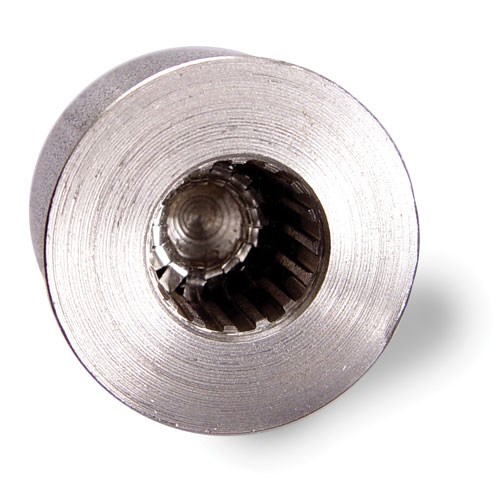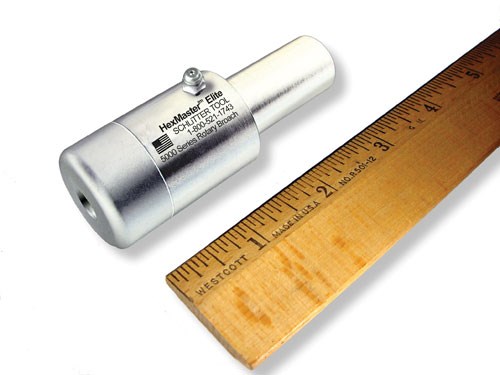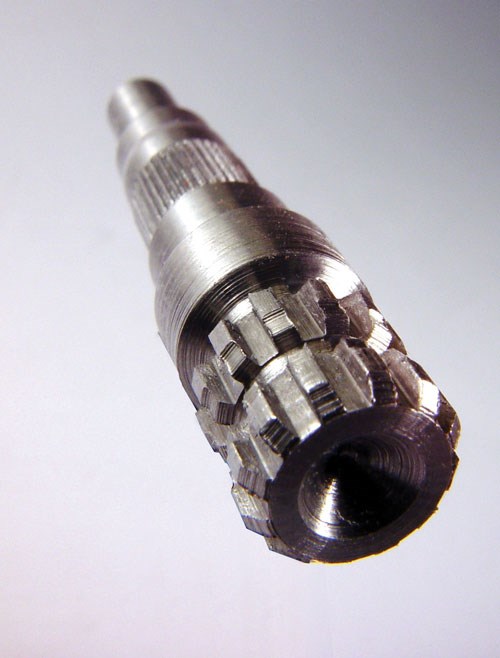Small-Scale Rotary Broaching
As a broached form gets smaller, tool centering becomes increasingly important and thrust forces less significant. Rather than simply scaling down larger product designs, this company developed a small-scale rotary broaching tool that eliminates the need for an orbiting head and the need to adjust the holder for different tool lengths.
Developing products for smaller-scale applications (such as on Swiss-type lathes) is an engineering challenge. There’s a tendency for companies to skip engineering and simply shrink existing designs to fit the new work envelope. While opting for this shortcut can save time and money for the company, it often results in an inferior product for the customer. However, some engineers understand that designing products for smaller scales represents an opportunity to improve on the original design and to optimize tooling for maximum quality and productivity.
An example of the considerations needed in scaling product designs can be seen in rotary broaching attachments optimized for small forms to as large as 3/8 inch in diameter. As with larger lines of broaching attachments, they use an orbiting action to reduce the thrust forces required to broach the work. A by-product of the orbiting action is the necessity to center tools of different lengths on the work during setup. This involves either presetting the holder on a workbench or indicating the tool to centerline and making adjustments to the holder while mounted in the machine.
As a broached form gets smaller, tool centering becomes increasingly important and thrust forces become irrelevant. Instead of simply shrinking existing designs to fit the smaller work envelope or offering preset holders requiring an exact tool length, engineers from Schlitter Tool (Warren, Michigan) took the time to understand small-scale rotary broaching. The result is what the company considers a superior tool for small-scale broaching applications. The HexMaster Elite 5000 Series eliminates both the need for an orbiting head and the need to adjust the holder for different tool lengths. Relative to large-scale broaching, these attachments are designed to simplify setup, synchronize more quickly with work (reducing pickup marks), reduce vibration and virtually eliminate the spiraling associated with orbiting designs. The simplified design eliminates secondary operations, therefore improving production times and profits.
Creating Complex Forms
Rotary broaching is a relatively easy and economical way to accurately machine polygon forms into the ID or OD of parts. Setup merely involves centering the tool on the work. With feeds slightly faster than drilling, complex forms can be quickly machined. Splines, hexes, serrations, and other shapes can be machined on a CNC lathe or mill, manual machine or screw machine. The process works equally well whether the part turns in a lathe or the holder spins in a machine and the part is fixtured.
Rotary broaching is similar to forming in that the process requires a tool that is customized to the part form. It is adaptable to a variety of forms including splines, hexes, Torx and irregular shapes. The actual cutting tool is carefully designed with the ideal front rake angle and back clearance to match the desired form in whatever part material is needed (typically unhardened metals). Tool design impacts the accuracy of the form, chip flow, finish and spiraling of the form in the part. The process can be used for both ID and OD work, but requires different holders and different tools. Broached parts are typically fasteners or parts that must be joined with other parts to make a secure assembly.
Feeds And Speeds
In terms of the actual cutting action, the speed of the tool is relatively insignificant. Unlike with a turning tool or drill, where the cut is made by using the rotation of the tool against the work, the rotary broaching tool is rotating with the work. But a spindle speed that is too slow will waste time, and one that is too fast can make it difficult for the free-spinning tool to pick up the work.
Feed rate, on the other hand, is critical to the rotary broaching process. If the feed is too light, a spiraling action will result because the tool is not aligned from the top to the bottom, and it is not engaging the work as well as it should. If the feed is too heavy, it will tax the bearings on the holder and excessive tool breakage will occur. Schlitter recommends a formula for determining the optimum feed based on the diameter of the tool.
For forms of 3/8 inch and less, Schlitter Tool recommends a starting feed rate of 0.004 inch IPR and a speed between 1,200 and 1,800 rpm. The typical process is to pre-drill the ID hole, chamfer slightly, broach the form and then reintroduce the drill to clean up any chips from the bottom of the form. Typical broach depths include length-to-diameter ratios of 1 to 1.5.
Specifications
The HexMaster Elite 5000 rotary broaching tools are designed specifically for small parts such as bone screws that make up the bulk of the work for Swiss and other small CNC machines. These tools fit easily in the palm of the hand, with a spindle that is only 1 3/16 inch in diameter and a body length of 1 7/8 inch (not including the shank). The ID series accepts a 0.315-inch (8-mm) tool shank and is available in a variety of inch and millimeter shank sizes to fit any small machine.
Read Next
Rotary Broaching 101
There continues to be new ways of driving fasteners into the materials they are intended to hold together.
Read MoreForming Hex Holes For Bone Screws
Close tolerances and quality surface finish are critical in successful medical machining. To meet such requirements in broaching titanium and stainless steel bone screws, with machined depths ranging anywhere between 0.080 and 0.150 inches, Hassay Savage Company (Turners Falls, Massachusetts) has recently developed an indexing-broach process using four-point or two-point punch broaches for use in Swiss-type CNC lathes.
Read More5 Aspects of PMTS I Appreciate
The three-day edition of the 2025 Precision Machining Technology Show kicks off at the start of April. I’ll be there, and here are some reasons why.
Read More















.jpg;maxWidth=300;quality=90)






